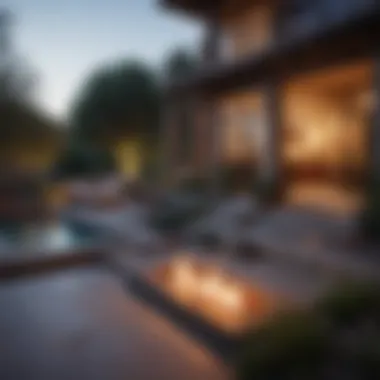Exploring Laguna Ridge: Mesa’s Architectural and Natural Harmony


Intro
The Mesa at Laguna Ridge stands as a noteworthy intersection of nature and architectural ambition. This exploration aims to unearth the intricate layers of design, landscape, and the lifestyle that this unique mesa fosters. Individuals interested in real estate, travel, and interior design will find valuable insights relevant to their interests. The analysis is not merely aesthetic; it delves into sustainable living practices and the harmony of physical structures with the environment.
Throughout this article, we will cover vital aspects that contribute to this landscape's allure. From the architectural significance that defines the homes on the mesa to the integration of innovative decor trends that enhance living spaces, each component is crucial for understanding how residents nurture their environment. The location of the mesa also plays a pivotal role in shaping the lifestyles of those who inhabit it. With breathtaking panoramic views and a community committed to sustainability, the Mesa at Laguna Ridge captivates and inspires.
Here, we invite you to navigate through this comprehensive guide, structured to provide insights that are both practical and appreciated in design circles, illuminating the synergy between contemporary living and the natural world.
Prelude to the Mesa at Laguna Ridge
The Mesa at Laguna Ridge stands as a unique intersection of architecture, nature, and community living. This section emphasizes the significance of understanding both the physical and cultural landscape of this remarkable area. By diving into the Mesa's geographical and historical dimensions, one can uncover the layers that create its identity. Recognizing these elements is crucial not only for potential residents but also for visitors and those interested in sustainable development. The Mesa is not just a location; it represents a philosophy of living harmoniously with the environment.
Geographical Overview
The geographical characteristics of the Mesa at Laguna Ridge are diverse and intriguing. Nestled in a region with rolling hills and scenic vistas, the area boasts a blend of natural beauty and accessibility. The topography includes varying elevations, providing panoramic views of the surrounding landscapes.
The climate is generally mild, which allows for a rich array of flora and fauna. This natural setting has significant implications for both architectural decisions and community living. Key features include:
- Proximity to water bodies: Lakes and streams enhance the area's appeal, promoting a sense of tranquility.
- Diverse vegetation: The local flora contributes to the ecosystem's richness, supporting wildlife and recreational activities.
By understanding the geography, potential residents and visitors grasp how it influences lifestyle choices, community planning, and environmental stewardship.
Historical Context
The history of the Mesa at Laguna Ridge is equally important in shaping its current identity. Originally inhabited by Indigenous peoples, this land presented a way of life deeply connected to nature. Traces of ancient settlements provide a glimpse into the sustainable practices of early inhabitants.
In more recent history, the area has seen significant developments that reflect changing architectural trends and community needs. The evolution of the Mesa is marked by:
- Architectural milestones: From traditional designs to contemporary aesthetics, each style has added depth and character.
- Cultural shifts: As populations have grown, the Mesa has adapted, fostering community ties among its residents.
Understanding this historical context allows for an appreciation of how the current community has emerged and evolved over time. It highlights the importance of preserving legacy while pursuing modern ideals.
Architectural Features
The architectural features of the Mesa at Laguna Ridge play a crucial role in defining its identity and overall experience. These attributes encompass various aspects, including the design principles, materials, and finishes used throughout the development. Understanding these components helps to appreciate how the environment and society interact within this area.
Design Principles
Minimalism
Minimalism represents a vital concept in contemporary architecture, focusing on simplicity and functionality. In the context of the Mesa, minimalism is both a design choice and a lifestyle philosophy. It emphasizes clean lines and uncluttered spaces, promoting a sense of calm and order.
A key characteristic of minimalism is its approach to space utilization. By minimizing unnecessary elements, it allows for greater focus on essential features. This approach is beneficial because it aids in creating environments that foster relaxation and mindfulness. The unique feature of minimalist design at the Mesa is its ability to blend seamlessly with the natural landscape, drawing inspiration from the surrounding beauty. However, one disadvantage might be that minimalism can sometimes be perceived as stark or cold, which may not appeal to everyone.
Sustainability
Sustainability has become increasingly important in design choices today. At the Mesa, sustainable practices are at the forefront of architectural planning. This principle encompasses using eco-friendly materials, efficient waste management, and energy conservation.
A significant aspect of sustainability is its environmental responsibility. It can often lead to lower operating costs for residents and better health outcomes. Specifically, using solar panels and rainwater harvesting systems illustrates how sustainability is embedded in the Mesa's architectural features. However, integrating sustainable practices can sometimes result in higher initial costs, which might deter potential homeowners.
Functionality
Functionality is also paramount in the architectural designs of the Mesa at Laguna Ridge. This principle focuses on the purpose of spaces and how they serve the needs of their occupants. A well-designed functional space encourages seamless daily activities and interactions.


The key highlight of functionality is its adaptability. Each space has been designed to accommodate various activities, making the living experience more enjoyable. For instance, open floor plans allow for flexibility in arrangements depending on the needs of the occupants. On the downside, an overemphasis on functionality might lead to sacrificing aesthetic elements, potentially resulting in a loss of visual appeal.
Materials and Finishes
The choice of materials and finishes is essential in reinforcing the architectural features of the Mesa. The emphasis on local sourcing, natural materials, and durability contributes to enriching the overall design and functionality of the community.
Local Sourcing
Local sourcing involves using materials that are obtainable from the immediate area. This practice not only supports local economies but also reduces the environmental impact associated with transporting materials over long distances.
The standout benefit of local sourcing is that it often results in a better fit with the environment. These materials are usually more suited to the climate and conditions of the Mesa, ensuring longevity and durability. An example of local sourcing could be the use of indigenous stone and timber in construction. Nonetheless, reliance on local materials can create challenges regarding availability and cost, particularly in times of high demand.
Natural Materials
Natural materials are essential in creating both aesthetic and functional elements of the architecture at Laguna Ridge. They include wood, stone, and clay, providing an organic feel that connects the built environment with nature.
The main characteristic of natural materials is their versatility and innate beauty. They often age gracefully, contributing to an evolving aesthetic that enhances the character of homes over time. Emphasizing natural materials adds to the sustainable approach of the Mesa. However, natural materials may require more maintenance compared to synthetic alternatives, which can be a consideration for homeowners.
Durability
Durability covers how well materials withstand wear and environmental conditions, which is crucial in architectural design. Owning a property constructed with durable materials can reduce maintenance needs and prolong its lifespan.
The advantage of focusing on durability is financial savings over time due to reduced repairs and replacements. For instance, durable roofing and siding materials can withstand harsh weather while requiring less frequent maintenance. On the downside, materials with high durability may come at a premium price initially, impacting the overall budget for construction.
"In crafting architecture that respects its surroundings, form and function coexist harmoniously at the Mesa."
Through an exploration of architectural features, readers can appreciate how these principles work together to create a thoughtful community that embodies both aesthetic and functional qualities.
Landscape Characteristics
The significance of landscape characteristics in Laguna Ridge extends far beyond mere aesthetics. They shape the environment and influence the way residents interact with nature. Each unique aspect contributes to a sense of place, establishing a connection that enriches both physical and emotional well-being. By examining natural features, such as topography, vegetation, and water bodies, we unearth intrinsic benefits that enhance the characters of this region.
Natural Features
Topography
The topography of Laguna Ridge is a defining characteristic. It features a variety of elevation changes, which creates a unique landscape. This range encourages diverse ecosystems and habitats. The varied elevation also provides stunning views and a sense of privacy for residents. Such diversity in topography can be advantageous. It promotes a rich biodiversity and supports various wildlife species. However, it can also present challenges, such as erosion risks in areas with steep slopes. For these reasons, understanding topography is essential.
Vegetation
Vegetation is another significant component of the landscape at Laguna Ridge. The flora includes native plants that thrive in local conditions. This not only ensures the survival of local species but also creates a beautiful natural setting. The carefully chosen vegetation contributes to the ambiance and enhances property values in the area. Furthermore, native plants require less water and maintenance compared to non-native species. However, there is a challenge in ensuring that invasive plant species do not disrupt these natural ecosystems.
Water Bodies
Water bodies, such as lakes and streams, are central to the Laguna Ridge landscape. They provide essential resources for wildlife and contribute to the region's biodiversity. In addition, these bodies of water offer recreational options for residents. Activities like fishing, kayaking, or simply enjoying the scenery foster a healthy lifestyle. The presence of water is generally seen as a favorable characteristic in real estate. It can significantly increase property value. Nonetheless, water bodies may come with challenges, such as flood risks or management of water quality, which need careful consideration.
Ecological Impact
The ecological impact of Laguna Ridge landscape is profound. Not only does it host a variety of species, but it also contributes in several ways to the local ecosystem. The elements of biodiversity, preservation efforts, and community initiatives can help in maintaining this balance and fostering a sustainable environment.
Biodiversity
Biodiversity is crucial for the resilience of the Laguna Ridge ecosystem. A wide variety of species can enhance stability and adaptability. This diversity offers various ecological benefits, such as natural pest control and soil health. The unique flora and fauna contribute to the cultural identity of the area. However, it can be affected by changes in land use and climate. Protecting biodiversity should be a priority.


Preservation Efforts
Preservation efforts are essential in maintaining the landscape characteristics of Laguna Ridge. Local organizations advocate for sustainable practices that protect natural habitats from development. These initiatives have shown real benefits, contributing to ecosystem health and increasing community awareness of local environmental issues. Yet, preservation efforts require funding and community participation to be effective.
Community Initiatives
Community initiatives play a vital role in the ecological sustainability of Laguna Ridge. Programs promote engagement in conservation efforts and educate residents about environmental practices. These initiatives help foster a stronger sense of community while ensuring the landscape's integrity. However, community involvement can vary, which may pose challenges in maintaining consistent support.
Living in the Mesa
Living in the Mesa offers a unique blend of community, environment, and lifestyle that stands out. The interaction of architectural innovation with natural landscapes creates a harmonious living experience. This section aims to shed light on various dimensions of life within the Mesa, from cultural engagement to real estate dynamics. The environment fosters a strong sense of belonging and engagement among residents, enhancing their everyday experiences.
Community Lifestyle
Cultural Events
Cultural events in the Mesa serve as a cornerstone for community engagement. They bring residents together, fostering connections and creating bonds. These events celebrate local traditions, arts, and history. For instance, annual festivals highlight local crafts and culinary delights. The interactive nature of these events promotes participation, which is pivotal for community spirit.
One unique feature of cultural events in the Mesa is the emphasis on local involvement. Residents often contribute by organizing or volunteering, leading to greater investment in community welfare. These opportunities facilitate social cohesion and provide a supportive network for newcomers. The challenge may arise from the planning of these events, which require collaboration and time commitment.
Social Infrastructure
Social infrastructure refers to the systems and facilities that support community interaction and services. In the Mesa, strong social infrastructure is evident in the availability of community centers, libraries, and public spaces. Each plays a vital role in daily community life by providing venues for gatherings, classes, and workshops. The attractiveness of such facilities lies in their accessibility and the programs they offer.
An important characteristic of social infrastructure in the Mesa is its focus on inclusivity. This ensures that all community members, regardless of age or background, have access to resources. A significant advantage of a robust social infrastructure is the promotion of community-driven initiatives, which can sometimes face challenges due to funding or resources.
Recreational Opportunities
Recreational opportunities abound in the Mesa, promoting a healthy and active lifestyle. Residents can engage in a multitude of outdoor activities such as hiking, biking, or attending fitness classes in the parks. The natural beauty of the area provides an ideal backdrop for these activities, enabling individuals to connect with nature while staying fit.
The key benefit of these recreational offerings is that they cater to various interests and ages. No matter one’s preference, from tranquil walks to more strenuous activities, there is something for everyone. However, the unique challenge may involve maintaining these spaces, as high usage can lead to wear and occasional disruptions.
Real Estate Insights
Market Trends
Understanding market trends is crucial for both potential buyers and current residents in the Mesa. The real estate market here has shown resilience, with demand continuing to rise alongside developments in infrastructure and amenities. Notable trends include an increase in eco-friendly properties, reflecting the community’s inclination toward sustainable living.
This trend is beneficial as it appeals to environmentally conscious buyers, who may prioritize energy efficiency and renewable materials. However, potential drawbacks can include rising property prices, challenging affordability for newcomers.
Investment Opportunities
Investment opportunities in the Mesa are diverse, appealing to a range of individuals. Property investors find value in the growing demand for rental spaces and short-term accommodations due to the area's increasing popularity among tourists. The potential for appreciation in value is a significant incentive for investors looking to maximize their returns.
A unique feature of investing in the Mesa is the potential for development projects that align with community goals. These projects could offer benefits such as infrastructure improvements and economic growth but may also encounter resistance from residents concerned about overdevelopment.
Living Spaces
Living spaces in the Mesa are characterized by a blend of modern design and sustainable practices. Many homes take advantage of the natural scenery, offering breathtaking views of the surrounding landscape. The residential architecture here reflects both form and function, prioritizing comfort while maintaining environmental consciousness.
One of the most attractive aspects of living spaces in the Mesa is the variety available. Whether seeking a contemporary home or a traditional structure, options abound. However, challenges within this market include balancing development with community aesthetics and ensuring that new constructions harmonize with the environment.
Visitor Experience


The visitor experience at the Mesa at Laguna Ridge plays a critical role in attracting both residents and tourists alike. This area harmoniously blends natural beauty with modern convenience, making it an ideal destination for various types of visitors. Understanding the components of this experience, such as traveling logistics, activities, and local attractions, is essential for fully appreciating what Laguna Ridge has to offer.
Traveling to the Mesa
Access Routes
Access routes to the Mesa are a major factor in enhancing visitor experience. One key characteristic of these routes is their accessibility, which simplifies the journey for both local and out-of-town visitors. Accessible routes like the Laguna Ridge Road provide stunning views, making the travel itself an enjoyable part of the experience.
However, one should consider potential traffic congestion during peak seasons. Overall, these routes offer a beneficial choice for visitors eager to explore the unique offerings of Laguna Ridge.
Transportation Facilities
Transportation facilities are another essential aspect significantly contributing to the visitor experience. The area boasts a well-established public transport system, including buses and shuttle services, allowing easy movement within and beyond the mesa. The presence of these facilities promotes convenience and accessibility for everyone who visits.
A unique feature here is the bike-sharing program, which encourages environmentally friendly travel. However, visitors should plan accordingly, as peak times may lead to a shortage of available bikes, especially during weekends.
Accommodations
Accommodations in the Mesa are designed to cater to various preferences and budgets. Options range from cozy bed-and-breakfasts to upscale hotels. Each accommodation type provides unique experiences tailored to diverse visitor needs. The local inns often focus on sustainability, aligning with the lifestyle promoted by the area.
A notable highlight is the ocean-view lodges, which offer incredible vistas that guests can enjoy directly from their rooms. However, it is advisable to book in advance during busy seasons to ensure availability.
Activities and Attractions
Outdoor Activities
Outdoor activities are a cornerstone of the visitor experience at Laguna Ridge. The region's natural surroundings invite guests to engage in various activities such as hiking, mountain biking, and bird watching. More popular trails, like the Laguna Ridge Loop Trail, cater to different skill levels and provide excellent opportunities to immerse oneself in nature.
The unique feature of outdoor activities here is the emphasis on guided tours that enhance the visitor's connection to the environment. However, caution should be exercised during inclement weather, as some trails may become treacherous.
Cultural Sites
Cultural sites in the Mesa area enrich the visitor's understanding of local history and heritage. These sites, including the Laguna Ridge Heritage Center, offer guided tours and immersive experiences. They serve as an educational resource for tourists eager to learn about the region's past.
These cultural sites present a key characteristic: interactive exhibits that encourage visitors to engage actively with the content. However, opening hours may vary, so it is wise to check schedules beforehand to avoid disappointment.
Dining Options
Dining options at the Mesa greatly enhance the visitor experience by presenting a diverse culinary scene. From local eateries serving farm-to-table cuisine to high-end establishments, the area has choices for everyone. A spotlight on casual dining places is the Mesa Grill, known for its innovative use of local ingredients.
The unique feature here is the availability of outdoor dining options which allow guests to enjoy meals with stunning sunset views. It is advisable to make reservations in advance, especially during weekends, as popular spots fill up quickly.
Epilogue and Future Perspectives
The conclusion section encapsulates the essence of Laguna Ridge and its significance within the broader context of sustainable living and architectural innovation. The dialogue around sustainable development holds substantial weight as society leans toward eco-consciousness in design and living. This section aims to distill the core concepts discussed throughout the article and shed light on the future trajectory of this remarkable area.
Sustainable Development Considerations
Sustainable development at Laguna Ridge emphasizes integrating ecological principles into architectural and landscape design. Key considerations include:
- Resource Management: Effective use of local resources minimizes the carbon footprint of construction and maintains regional character.
- Energy Efficiency: Homes and buildings are designed with energy-saving technologies that facilitate long-term utility savings.
- Community Engagement: Involving residents in sustainable practices cultivates a sense of ownership and responsibility towards the environment.
The implications of these considerations extend beyond the immediate benefits. They promote a lifestyle that values harmony with nature and encourages responsible stewardship of resources. This focus not only enhances the region's appeal but also ensures its viability for future generations.
The Future of Laguna Ridge
As Laguna Ridge evolves, several trends indicate its potential trajectory. Notably, the growth of eco-tourism reveals an increasing interest in experiencing nature directly in residential and leisure spaces. Key elements to consider for the future include:
- Innovation in Design: Future developments are likely to prioritize innovative architectural techniques that align with sustainable living trends.
- Infrastructure Improvement: Enhanced transportation and community facilities will make the area more accessible while maintaining its natural allure.
- Cultural Integration: Continued emphasis on preserving the local culture and history of the Mesa can enrich community ties and foster visitor interest.
The vision for Laguna Ridge is not merely to create dwellings but to establish a lifestyle that celebrates nature and community togetherness.







